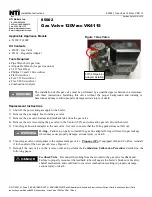
1. Installation Requirements - Page 5
General Information
•
Both the user and the manufacturer rely heavily on the
installer, whose job it is to install the combination boiler,
and connect it to a correctly designed heating system.
Acquaint yourself with the British Standards concerning
installation requirements.
It is recommended that tools suitable for brass fittings
are used, and have a capability to accommodate
hexagon sizes up to 50 mm.
Please read the information on Inhibitors - Page 12.
Manufacturers instructions must not be taken in any way
as over-riding statutory obligations.
1.1
Gas Supply
•
The local Gas Region should be consulted, at the
installation planning stage, in order to establish the
availability of an adequate supply of gas.
•
An existing service pipe must NOT be used without prior
consultation with the Local Gas Region.
•
A gas meter can only be connected by the Local Gas
Region, or by a Local Gas Region Contractor.
•
An existing meter should be checked, preferably by the
Gas Region, to ensure the meter is adequate to deal
with the rate of gas supply required.
•
Installation pipes should be fitted in accordance with BS
6891.
•
Pipework from the meter to the combination boiler must
be of an adequate size.
•
Do NOT use pipes of a smaller size than the
combination boiler inlet gas connection (15mm).
•
The complete installation must be tested for gas
soundness and purged as described in BS 6891.
1.2
Electrical Supply
•
Wiring external to the appliance MUST be in accordance
with the current I.E.E. Regulations for Electrical
Installations, and any Local Regulations which apply.
The combination boiler is supplied for 230 Volts ~ 50 Hz,
Single Phase. To protect the appliance it is essential
that the electrical supply is fused at 3 A rating.
•
THIS APPLIANCE MUST BE EARTHED.
•
The method of connection to the mains electricity supply
must provide means of completely isolating the electrical
supply to the combination boiler and its ancillary
controls.
•
The appliance is designed to be the wiring centre for the
installation, therefore no additional live supplies are
required from either timers or room thermostats.
•
Isolation is preferably by the use of a fused three-pin
plug and unswitched shuttered socket-outlet, both
complying with the requirements of BS 1363. OR a
3 A
fused
double-pole switch, having a 3mm contact
separation on both poles can be used. It is important
that the point of connection to the mains should be
readily accessible and adjacent to the combination
boiler.
Summary of Contents for Combi 80
Page 6: ...Installation Requirements Page 6 Fig 3 ...
Page 23: ...Servicing Routine Maintenance Page 23 ...
Page 25: ...Servicing Routine Maintenance Page 25 ...
Page 29: ...Replacement of Parts Page 29 Fig 18 ...
Page 39: ...7 Electrical Layouts Page 39 Control Flow Sequence ...
Page 40: ...Functional Flow Page 40 ...
Page 41: ...Electrical Diagram Page 41 ...
Page 43: ...9 Optional Extras Page 43 ...
Page 44: ...Optional Extras Page 44 ...
Page 45: ...Optional Extras Page 45 ...






































